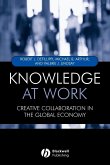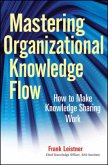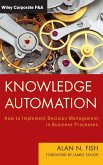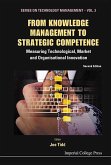Christine van Winkelen, Jane McKenzie
Knowledge Works
The Handbook of Practical Ways to Identify and Solve Common Organizational Problems for Better Performance
Christine van Winkelen, Jane McKenzie
Knowledge Works
The Handbook of Practical Ways to Identify and Solve Common Organizational Problems for Better Performance
- Gebundenes Buch
- Merkliste
- Auf die Merkliste
- Bewerten Bewerten
- Teilen
- Produkt teilen
- Produkterinnerung
- Produkterinnerung
This book presents practical guidance in a highly accessible format on how to improve the way knowledge is used in organizations to solve common organizational problems. It is intended to be a handy guide for whenever knowledge and learning are seen as a factor affecting organisational performance.
The book provides organizations with tools to assist them in making connections between different areas of knowledge inside and outside the enterprise to keep ideas fresh and vital. It addresses practical ways to overcome the inevitable contradictions that arise when people work across interfaces in messy business contexts.…mehr
Andere Kunden interessierten sich auch für
![Effective Knowledge Management Effective Knowledge Management]() Sultan KermallyEffective Knowledge Management63,99 €
Sultan KermallyEffective Knowledge Management63,99 €![Knowledge Management Knowledge Management]() Carl FrappaoloKnowledge Management21,99 €
Carl FrappaoloKnowledge Management21,99 €![Knowledge at Work Knowledge at Work]() Robert DefillippiKnowledge at Work43,99 €
Robert DefillippiKnowledge at Work43,99 €![Mastering Organizational Knowledge Flow Mastering Organizational Knowledge Flow]() Frank LeistnerMastering Organizational Knowledge Flow26,99 €
Frank LeistnerMastering Organizational Knowledge Flow26,99 €![Knowledge Automation Knowledge Automation]() Alan N. FishKnowledge Automation46,99 €
Alan N. FishKnowledge Automation46,99 €![From Knowledge Management to Strategic Competence: Measuring Technological, Market and Organisational Innovation (Second Edition) From Knowledge Management to Strategic Competence: Measuring Technological, Market and Organisational Innovation (Second Edition)]() Joe TiddFrom Knowledge Management to Strategic Competence: Measuring Technological, Market and Organisational Innovation (Second Edition)146,99 €
Joe TiddFrom Knowledge Management to Strategic Competence: Measuring Technological, Market and Organisational Innovation (Second Edition)146,99 €![Knowledge Management and Risk Strategies Knowledge Management and Risk Strategies]() Akira IshikawaKnowledge Management and Risk Strategies67,99 €
Akira IshikawaKnowledge Management and Risk Strategies67,99 €-
-
-
This book presents practical guidance in a highly accessible format on how to improve the way knowledge is used in organizations to solve common organizational problems. It is intended to be a handy guide for whenever knowledge and learning are seen as a factor affecting organisational performance.
The book provides organizations with tools to assist them in making connections between different areas of knowledge inside and outside the enterprise to keep ideas fresh and vital. It addresses practical ways to overcome the inevitable contradictions that arise when people work across interfaces in messy business contexts.
The book provides organizations with tools to assist them in making connections between different areas of knowledge inside and outside the enterprise to keep ideas fresh and vital. It addresses practical ways to overcome the inevitable contradictions that arise when people work across interfaces in messy business contexts.
Produktdetails
- Produktdetails
- Verlag: Wiley & Sons
- 1. Auflage
- Seitenzahl: 328
- Erscheinungstermin: 15. August 2011
- Englisch
- Abmessung: 244mm x 175mm x 25mm
- Gewicht: 716g
- ISBN-13: 9781119993629
- ISBN-10: 1119993628
- Artikelnr.: 33392797
- Herstellerkennzeichnung
- Libri GmbH
- Europaallee 1
- 36244 Bad Hersfeld
- gpsr@libri.de
- Verlag: Wiley & Sons
- 1. Auflage
- Seitenzahl: 328
- Erscheinungstermin: 15. August 2011
- Englisch
- Abmessung: 244mm x 175mm x 25mm
- Gewicht: 716g
- ISBN-13: 9781119993629
- ISBN-10: 1119993628
- Artikelnr.: 33392797
- Herstellerkennzeichnung
- Libri GmbH
- Europaallee 1
- 36244 Bad Hersfeld
- gpsr@libri.de
Christine van Winkelen has worked with the Henley KM Forum since its inception in 2000 and was the Director for five years until February 2009. Having led, or otherwise been involved in, a high proportion of the research projects completed by the Forum over the last decade, she is in a unique position to write this book. Previous experience includes fifteen years in various roles in high technology organizations (including research, human resource management and product management). Jane McKenzie has worked with the Henley KM Forum since its inception in 2000 and took over from Christine van Winkelen as Director of the Forum in 2009. Like Christine she has led or been involved in many of the research projects completed since 2000, and they have co-authored many papers together, as well as a book in 2004. She developed broad experience in a variety of financial, marketing and operations management roles during her 15 years in industry in both large organizations and SMEs, and working for a while as a consultant convinced her of the value of "joining up the dots" in organizations. The Henley Knowledge Management Forum is one of the Centres of Excellence at Henley Business School in the UK, a school well-known for executive development. Established in 2000, the Knowledge Management Forum brings together business practitioners, industry thought-leaders, experts and academics to help organizations tackle the new challenges presented by the knowledge economy. Members are large multi-national organizations in all sectors, as well as UK public and third sector bodies. http://www.henley.reading.ac.uk/kmforum
Introduction.
A handbook that you can dip into according to your needs, or that you can
work through in a more systematic way to improve your organization's
performance.
SECTION I: Establish strategic priorities.
By understanding from the outset the sort of knowledge that makes a
difference to your organization's performance you can focus limited
resources of time and attention on the things that will have the biggest
impact in terms of generating value.
CHAPTER 1:Identifying valuable knowledge.
CHAPTER 2:Making a comprehensive assessment of knowledge flows.
Section II: Enable operational effectiveness.
By connecting well established knowledge-sharing practices with core
business activities you can avoid "reinventing the wheel" and do more with
less.
CHAPTER 3:Taking knowledge initiatives to the front line of the
organization.
CHAPTER 4:Integrating knowledge practices into projects.
CHAPTER 5:Working collaboratively in partnerships.
Section III: Stimulate innovation.
By retaining and developing expertise and understanding how to combine
knowledgebased methods and approaches more effectively, you generate more
innovation.
CHAPTER 6:Building knowledge enabled innovation capability.
CHAPTER 7:Retaining and developing expertise.
Section IV: Increase learning capacity.
By creating mechanisms to join up the learning that is happening around the
organization, you create the conditions for greater operational
effectiveness and stimulate new thinking and innovation.
CHAPTER 8:Joining up individual and organizational learning.
CHAPTER 9:Extracting knowledge value using document management systems.
CHAPTER 10:Sustaining effective communities of practice.
CHAPTER 11:Learning from external collaborations.
Section V: Become more agile.
By creating the conditions that help people adapt their knowledge and
understanding to the constant turbulence in the outside world, the
organization can become more responsive to new challenges.
CHAPTER 12:Making more knowledgeable decisions.
CHAPTER 13:Using social media for knowledge sharing.
CHAPTER 14:Transforming relationships and structures in organizations.
Section VI: Make change stick.
By developing key knowledge-sharing behaviours and using effective
communication approaches you show people why a knowledge approach matters
and what they need to do themselves to contribute.
CHAPTER 15:Developing knowledge-sharing behaviours and effective knowledge
activists.
CHAPTER 16:Moving from hard sell to compelling buy.
CHAPTER 17:Improving the quality of conversations.
CHAPTER 18:Taking account of national culture in designing knowledge
initiatives.
Index.
A handbook that you can dip into according to your needs, or that you can
work through in a more systematic way to improve your organization's
performance.
SECTION I: Establish strategic priorities.
By understanding from the outset the sort of knowledge that makes a
difference to your organization's performance you can focus limited
resources of time and attention on the things that will have the biggest
impact in terms of generating value.
CHAPTER 1:Identifying valuable knowledge.
CHAPTER 2:Making a comprehensive assessment of knowledge flows.
Section II: Enable operational effectiveness.
By connecting well established knowledge-sharing practices with core
business activities you can avoid "reinventing the wheel" and do more with
less.
CHAPTER 3:Taking knowledge initiatives to the front line of the
organization.
CHAPTER 4:Integrating knowledge practices into projects.
CHAPTER 5:Working collaboratively in partnerships.
Section III: Stimulate innovation.
By retaining and developing expertise and understanding how to combine
knowledgebased methods and approaches more effectively, you generate more
innovation.
CHAPTER 6:Building knowledge enabled innovation capability.
CHAPTER 7:Retaining and developing expertise.
Section IV: Increase learning capacity.
By creating mechanisms to join up the learning that is happening around the
organization, you create the conditions for greater operational
effectiveness and stimulate new thinking and innovation.
CHAPTER 8:Joining up individual and organizational learning.
CHAPTER 9:Extracting knowledge value using document management systems.
CHAPTER 10:Sustaining effective communities of practice.
CHAPTER 11:Learning from external collaborations.
Section V: Become more agile.
By creating the conditions that help people adapt their knowledge and
understanding to the constant turbulence in the outside world, the
organization can become more responsive to new challenges.
CHAPTER 12:Making more knowledgeable decisions.
CHAPTER 13:Using social media for knowledge sharing.
CHAPTER 14:Transforming relationships and structures in organizations.
Section VI: Make change stick.
By developing key knowledge-sharing behaviours and using effective
communication approaches you show people why a knowledge approach matters
and what they need to do themselves to contribute.
CHAPTER 15:Developing knowledge-sharing behaviours and effective knowledge
activists.
CHAPTER 16:Moving from hard sell to compelling buy.
CHAPTER 17:Improving the quality of conversations.
CHAPTER 18:Taking account of national culture in designing knowledge
initiatives.
Index.
Introduction.
A handbook that you can dip into according to your needs, or that you can
work through in a more systematic way to improve your organization's
performance.
SECTION I: Establish strategic priorities.
By understanding from the outset the sort of knowledge that makes a
difference to your organization's performance you can focus limited
resources of time and attention on the things that will have the biggest
impact in terms of generating value.
CHAPTER 1:Identifying valuable knowledge.
CHAPTER 2:Making a comprehensive assessment of knowledge flows.
Section II: Enable operational effectiveness.
By connecting well established knowledge-sharing practices with core
business activities you can avoid "reinventing the wheel" and do more with
less.
CHAPTER 3:Taking knowledge initiatives to the front line of the
organization.
CHAPTER 4:Integrating knowledge practices into projects.
CHAPTER 5:Working collaboratively in partnerships.
Section III: Stimulate innovation.
By retaining and developing expertise and understanding how to combine
knowledgebased methods and approaches more effectively, you generate more
innovation.
CHAPTER 6:Building knowledge enabled innovation capability.
CHAPTER 7:Retaining and developing expertise.
Section IV: Increase learning capacity.
By creating mechanisms to join up the learning that is happening around the
organization, you create the conditions for greater operational
effectiveness and stimulate new thinking and innovation.
CHAPTER 8:Joining up individual and organizational learning.
CHAPTER 9:Extracting knowledge value using document management systems.
CHAPTER 10:Sustaining effective communities of practice.
CHAPTER 11:Learning from external collaborations.
Section V: Become more agile.
By creating the conditions that help people adapt their knowledge and
understanding to the constant turbulence in the outside world, the
organization can become more responsive to new challenges.
CHAPTER 12:Making more knowledgeable decisions.
CHAPTER 13:Using social media for knowledge sharing.
CHAPTER 14:Transforming relationships and structures in organizations.
Section VI: Make change stick.
By developing key knowledge-sharing behaviours and using effective
communication approaches you show people why a knowledge approach matters
and what they need to do themselves to contribute.
CHAPTER 15:Developing knowledge-sharing behaviours and effective knowledge
activists.
CHAPTER 16:Moving from hard sell to compelling buy.
CHAPTER 17:Improving the quality of conversations.
CHAPTER 18:Taking account of national culture in designing knowledge
initiatives.
Index.
A handbook that you can dip into according to your needs, or that you can
work through in a more systematic way to improve your organization's
performance.
SECTION I: Establish strategic priorities.
By understanding from the outset the sort of knowledge that makes a
difference to your organization's performance you can focus limited
resources of time and attention on the things that will have the biggest
impact in terms of generating value.
CHAPTER 1:Identifying valuable knowledge.
CHAPTER 2:Making a comprehensive assessment of knowledge flows.
Section II: Enable operational effectiveness.
By connecting well established knowledge-sharing practices with core
business activities you can avoid "reinventing the wheel" and do more with
less.
CHAPTER 3:Taking knowledge initiatives to the front line of the
organization.
CHAPTER 4:Integrating knowledge practices into projects.
CHAPTER 5:Working collaboratively in partnerships.
Section III: Stimulate innovation.
By retaining and developing expertise and understanding how to combine
knowledgebased methods and approaches more effectively, you generate more
innovation.
CHAPTER 6:Building knowledge enabled innovation capability.
CHAPTER 7:Retaining and developing expertise.
Section IV: Increase learning capacity.
By creating mechanisms to join up the learning that is happening around the
organization, you create the conditions for greater operational
effectiveness and stimulate new thinking and innovation.
CHAPTER 8:Joining up individual and organizational learning.
CHAPTER 9:Extracting knowledge value using document management systems.
CHAPTER 10:Sustaining effective communities of practice.
CHAPTER 11:Learning from external collaborations.
Section V: Become more agile.
By creating the conditions that help people adapt their knowledge and
understanding to the constant turbulence in the outside world, the
organization can become more responsive to new challenges.
CHAPTER 12:Making more knowledgeable decisions.
CHAPTER 13:Using social media for knowledge sharing.
CHAPTER 14:Transforming relationships and structures in organizations.
Section VI: Make change stick.
By developing key knowledge-sharing behaviours and using effective
communication approaches you show people why a knowledge approach matters
and what they need to do themselves to contribute.
CHAPTER 15:Developing knowledge-sharing behaviours and effective knowledge
activists.
CHAPTER 16:Moving from hard sell to compelling buy.
CHAPTER 17:Improving the quality of conversations.
CHAPTER 18:Taking account of national culture in designing knowledge
initiatives.
Index.








